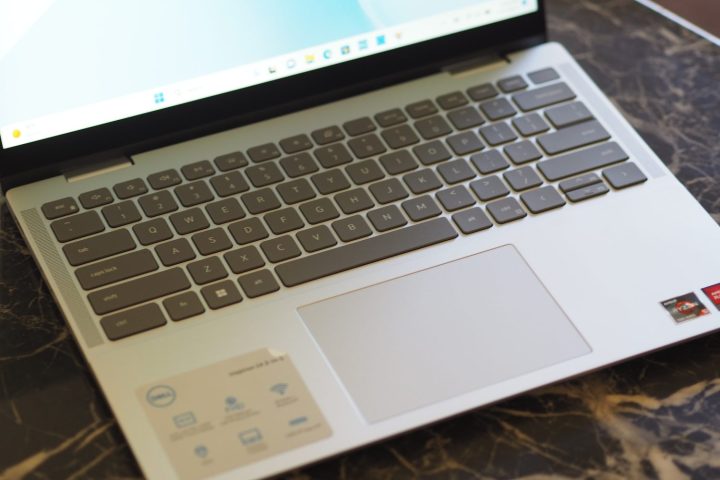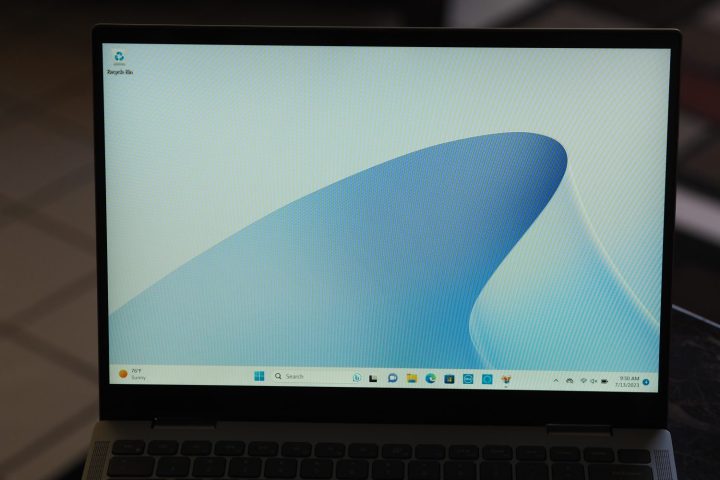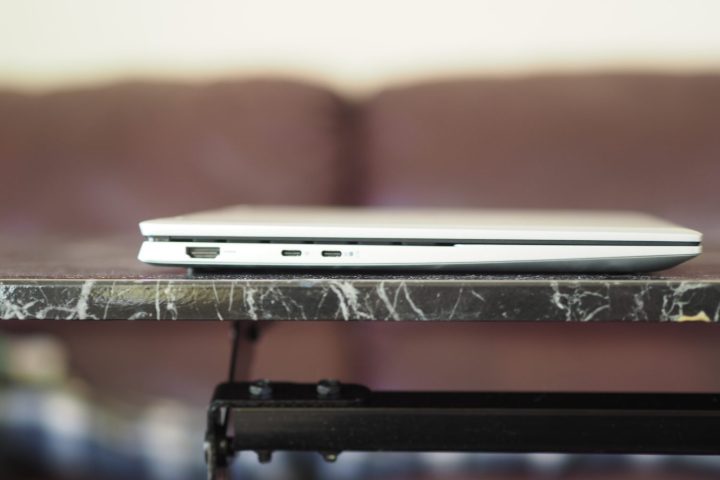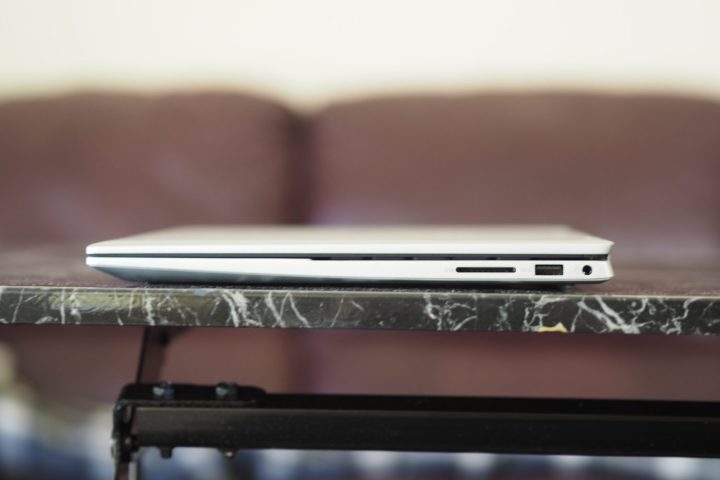“The Dell Inspiron 14 2-in-1 has great battery life, but suffers from a flimsy plastic build and disappointing display.”
- Competent productivity performance
- Excellent battery life
- Attractive entry-level price on sale
- Good keyboard
- Inferior display
- Fans run too often
- Touchpad buttons too stiff
- A bit pricey at the high end
Dell’s Inspiron line is its budget laptop or near-budget offering, falling below the XPS lineup and aiming to offer a solid computing experience for less money. I’ve had mixed results with Inspiron laptops, and unfortunately, the latest Inspiron 14 2-in-1 falls into the lesser side of that equation.
While it provides good enough performance and very good battery life, its all-plastic construction is becoming an anachronism and its display simply isn’t good enough by modern standards. You can get it for an attractive entry-level price, but it has way too much competition to successfully compete even at these prices.
Specs and configurations
| Dell Inspiron 14 2-in-1 2023 | |
| Dimensions | 12.36 inches x 8.92 inches x 0.61-0.73 inches |
| Weight | 3.48 pounds |
| Processor | AMD Ryzen 5 7530U AMD Ryzen 7 7730U |
| Graphics | AMD Radeon graphics |
| RAM | 8GB LPDDR4 16GB LPDDR4 |
| Display | 14.0-inch 16:10 FHD+ (1920 x 1200) IPS |
| Storage | 256GB SSD 512GB SSD 1TB SSD 2TB SSD |
| Touch | Yes |
| Ports | 2 x USB-C 3.2 Gen 2 1 x USB-A 3.2 Gen 2 1 x HDMI 1.4 1 x 3.5mm audio jack 1 x full-size SD card reader |
| Wireless | Wi-Fi 6E and Bluetooth 5.2 |
| Webcam | 1080p |
| Operating system | Windows 11 |
| Battery | 54 watt-hour 64 watt-hour |
| Price | $650+ |
My Inspiron 14 2-in-1 review unit is currently listed in Dell’s store for $650, with an AMD Ryzen 5 7530U CPU, 8GB of RAM, a 512GB SSD, and the only 14.0-inch FHD+ IPS panel offered with the laptop. That’s an attractive price for a convertible 2-in-1 with Dell’s performance and battery life. Upgrading to a Ryzen 7 7730U, 16GB of RAM, and a 1TB SSD raises the price to $950, which is less of a bargain. You can get some other great laptops for the same or less money with similar performance, such as the Asus ZenBook 14 OLED that tosses in a much better display.
Note that Dell also sells an Intel version of the Inspiron 14 2-in-1 that starts at $550 for a Core i5-1355U and maxes out at $850 with the same RAM, storage, and display. You’d likely get similar performance from the Intel models but less battery life, with the advantage of Thunderbolt 4 ports that the AMD version lacks.
A decidedly budget design

The Inspiron 14 2-in-1 is one of the first all-plastic laptops I’ve reviewed in a while. That’s not inherently a bad thing, but it’s becoming more unusual on all but the cheapest laptops. At Dell’s top price of $950, it stands out, and not in a good way. Overall, the build quality wasn’t bad, with a lid that’s just slightly bendable and some flex in the keyboard deck and palm rest.
The Asus ZenBook 14 OLED, which is the best comparison machine, was sturdier. Most other laptops I’ve reviewed in this price range are made of aluminum and so have generally been more rigid as well. I’ll also note that the hinge was a bit tight and both hands were required to open the lid, but that meant the display was held firmly in place in all four modes – clamshell, media, tent, and tablet.

The laptop isn’t particularly small thanks to larger top and bottom display bezels, and it’s rather thick at 0.73 inches at the rear. It weighs 3.48 pounds, which is getting a bit heavy for a 14-inch laptop. As a comparison, the Acer Swift Go 14 is just 0.59 inches thick and weighs just 2.76 pounds. The Inspiron 14 2-in-1 is still a portable laptop, but it doesn’t lead the class.
In terms of its aesthetics, the Inspiron 14 2-in-1 is offered in two colors, my review unit’s Platinum Silver and Lavender Blue. I sound like a broken record lately, but the laptop has a minimalist design without any bling. That’s true of most laptops I’ve reviewed over the last couple of years. The industry has settled on simplistic aesthetics that make for attractive, if bland, laptops. Probably, that’s a good thing compared to some of the chrome-heavy monstrosities of years past.

While the keyboard has good keycap size and key spacing, the switches seemed a bit loose to me. The bottoming action was comfortable, but I would have preferred more feedback. It’s not a bad keyboard, but the Asus and Acer keyboards are better at this price. The touchpad is large enough and has a smooth, comfortable surface, but the buttons are way too stiff. I was constantly tripped up by the amount of pressure I needed to apply to engage a click.
You get a lot of ports with the Inspiron 14 2-in-1, but thanks to the AMD chipset you don’t get Thunderbolt 4. The full-size SD card reader is welcome. Wireless connectivity is up to date.
Finally, the webcam is 1080p and provides good enough quality for videoconferencing. There’s no infrared camera for Windows 11 Hello facial recognition, but the fingerprint reader embedded in the power button is fast and reliable.
Decent, but loud, performance

My review unit was built around the AMD Ryzen 5 7530U, a 15-watt CPU with six cores and 12 threads running at up to 4.5GHz. In terms of performance, it compares well against the Intel Core i7-1355U, a 15-watt chip with 10 cores (two Performance at 5GHz and eight Efficient at 3.7GHz) and 12 threads. At least, it’s comparable when you’re running multi-core apps. The AMD, as usual, is considerably slower in single-core processes.
In real-world use, the Inspiron 14 2-in-1 should provide competent productivity performance and handle demanding (but typical) workflows. You won’t want to use the laptop for your creative work or for gaming thanks to the integrated Radeon graphics, which scored particularly low in the 3DMark Time Spy test even for integrated graphics.

You can get a slight boost by switching to performance mode, but the fans spin up and get pretty loud for a 14-inch laptop. That’s not much of a compromise, though, given that the fans on my review unit were running much of the time even in normal mode when the laptop was idle. So the thermal system is either poorly tuned or struggles to keep things cool even when you’re not actively using the laptop. You can switch to quiet mode, which helps, but performance will suffer.
| Geekbench 5 (single/multi) |
Handbrake (seconds) |
Cinebench R23 (single/multi) |
PCMark 10 Complete |
|
| Dell Inspiron 14 2-in-1 2023 (Ryzen 5 7530U) |
Bal: 1,471 / 6,134 Perf: 1,474 / 6,427 |
Bal: 151 Perf: 131 |
Bal: 1,436 / 6,402 Perf: 1,451 / 7,680 |
5,689 |
| Asus Zenbook 14 OLED (Ryzen 5 7530U) |
Bal: 1,457 / 7,527 Perf: 1,458 / 8,207 |
Bal: 123 Perf: 121 |
Bal: 1,457 / 7,527 Perf: 1,458 / 8,207 |
5,817 |
| Lenovo Yoga Book 9i (Core i7-1355U) |
Bal: 1,797 / 6,926 Perf: 1,804 / 7,815 |
Bal: 181 Perf: 118 |
Bal: 1,681 / 6,303 Perf: 1,758 / 7,576 |
5,514 |
| Asus Zenbook S 13 OLED 2023 (Core i7-1355U) |
Bal: 1,829 / 6,893 Perf: 1,836 / 6,908 |
Bal: 157 Perf: 135 |
Bal: 1,629 / 6,005 Perf: 1,827 / 6,962 |
5,423 |
| Lenovo Yoga 9i Gen 8 (Core i7-1360P) |
Bal: 1,843 / 8,814 Perf: 1,835 / 10,008 |
Bal: 122 Perf: 101 |
Bal: 1,846 / 8,779 Perf: 1,906 / 9,849 |
6,102 |
| Apple MacBook Air M2 (M2) |
Bal: 1,925 / 8,973 Perf: N/A |
Bal: 151 Perf: N/A |
Bal: 1,600 / 7,938 Perf: N/A |
N/A |
AMD processors can provide better battery life than their Intel counterparts. That was certainly true with the Asus ZenBook 14 OLED that got very good battery life with the same CPU as the Inspiron 14 2-in-1 and a more power-hungry OLED display.
According to our suite of battery tests, it was also true with the Inspiron 14 2-in-1. In each of our battery tests, the laptop exceeded the average by a fair margin. My review unit was equipped with a 54-watt-hour battery and there’s an option for 64Wh. That’s considerably less than the Asus ZenBook 14 OLED’s 75Wh, making the Inspiron 14 2-in-1’s longevity even more impressive.
You should be able to get through a full day’s work without carrying your charger.
| Web browsing | Video | PCMark 10 Applications | |
| Dell Inspiron 14 2-in-1 2023 (Ryzen 5 7530U) |
12 hours, 7 minutes | 14 hours, 19 minutes | 13 hours, 41 minutes |
| Asus Zenbook 14 OLED (Ryzen 5 7530U) |
12 hours, 13 minutes | 17 hours, 19 minutes | 14 hours, 23 minutes |
| Lenovo Yoga Book 9i (Core i7-1355U) |
8 hours, 53 minutes | 9 hours, 53 minutes | 11 hours, 20 minutes |
| Asus Zenbook S 13 OLED 2023 (Core i7-1355U) |
9 hours, 47 minutes | 15 hours, 14 minutes | 12 hours, 50 minutes |
| Lenovo Yoga 9i Gen 8 (Core i7-1360P) |
7 hours, 41 minutes | 13 hours, 25 minutes | 9 hours, 40 minutes |
| Apple MacBook Air M2 (Apple M2) |
17 hours, 59 minutes | 21 hours, 9 minutes | N/A |
A very disappointing display

In my Lenovo Flex 5i 14 2023 review, I dinged the laptop for having a rather colorless display. And indeed, its coverage of the sRGB and AdobeRGB gamuts was way below average and its color accuracy was poor. I mentioned how displays have been improving, and it had been some time since I last saw a display with conspicuously low results.
Coincidentally, the Inspiron 14 2-in-1 2023’s 14.0-inch FHD+ IPS panel is another step below. Not only did it hit the same 64% sRGB and 48% AdobeRGB numbers (compared to the average of 95% and 75%, respectively) as Lenovo’s, but its color accuracy was even worse at a Delta-E of 4.53 versus 3.11. We’re looking for less than 3.0 at a maximum, and preferably less than 2.0. But the Dell display also wasn’t as bright, at 263 nits compared to 329 nits, and our minimum preferred brightness level is 300 nits. The display’s only redeeming feature was its contrast ratio of 1130:1, exceeding our 1000:1 threshold.
I wasn’t impressed with the display when I first turned on the Inspiron 14 2-in-1, and my colorimeter just confirmed my subjective impressions. A couple of years ago I would have written this off to the laptop’s relatively low price and corners needing to be cut somewhere. Today, though, that’s hard to justify when you can get the Asus ZenBook 14 OLED for around the same money but with a spectacular display.

The two upward-firing speakers bracketing the keyboard are fine for watching the occasional YouTube video. But the volume doesn’t go very high, and while highs and mids are okay, there’s no bass. You’ll want to pull out your favorite headphones for listening to music or streaming TV shows and movies.
An old-school budget laptop that’s fallen behind
The Inspiron 14 2-in-1 is an okay laptop at $650, but it’s not good enough at $950. And even at its entry-level price, it’s beaten soundly by the Asus ZenBook 14 OLED which starts out just slightly more expensive with a gorgeous OLED display. It’s an odd coincidence that the last laptop I reviewed, the Lenovo Flex 5i 14, was almost identical in its overall value and received a very similar review.
Sure, you’ll get competent productivity performance from the Inspiron 14 2-in-1 and great battery life. Those are major plusses in its favor. But the overall construction and poor display hold it back from a recommendation.





